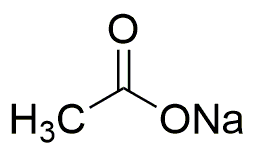Sodium acetate powder is widely utilized in research focused on:
- Food Preservation: It acts as a preservative in food products, helping to inhibit bacterial growth and extend shelf life, making it valuable for the food industry.
- Buffer Solutions: In biochemical research, it is commonly used to create buffer solutions that maintain pH levels, essential for various laboratory experiments.
- Textile Industry: Sodium acetate is employed in dyeing processes to improve color retention and enhance fabric quality, benefiting textile manufacturers.
- Pharmaceutical Applications: It serves as an ingredient in some medications and intravenous solutions, aiding in electrolyte balance and improving patient care.
- Heating Pads: The compound is used in reusable heating pads, providing a convenient and effective way to generate heat for pain relief.
General Information
Properties
Safety and Regulations
Applications
Sodium acetate powder is widely utilized in research focused on:
- Food Preservation: It acts as a preservative in food products, helping to inhibit bacterial growth and extend shelf life, making it valuable for the food industry.
- Buffer Solutions: In biochemical research, it is commonly used to create buffer solutions that maintain pH levels, essential for various laboratory experiments.
- Textile Industry: Sodium acetate is employed in dyeing processes to improve color retention and enhance fabric quality, benefiting textile manufacturers.
- Pharmaceutical Applications: It serves as an ingredient in some medications and intravenous solutions, aiding in electrolyte balance and improving patient care.
- Heating Pads: The compound is used in reusable heating pads, providing a convenient and effective way to generate heat for pain relief.
Documents
Safety Data Sheets (SDS)
The SDS provides comprehensive safety information on handling, storage, and disposal of the product.
Product Specification (PS)
The PS provides a comprehensive breakdown of the product’s properties, including chemical composition, physical state, purity, and storage requirements. It also details acceptable quality ranges and the product's intended applications.
Certificates of Analysis (COA)
Search for Certificates of Analysis (COA) by entering the products Lot Number. Lot and Batch Numbers can be found on a product’s label following the words ‘Lot’ or ‘Batch’.
*Catalog Number
*Lot Number
Certificates Of Origin (COO)
This COO confirms the country where the product was manufactured, and also details the materials and components used in it and whether it is derived from natural, synthetic, or other specific sources. This certificate may be required for customs, trade, and regulatory compliance.
*Catalog Number
*Lot Number
Safety Data Sheets (SDS)
The SDS provides comprehensive safety information on handling, storage, and disposal of the product.
DownloadProduct Specification (PS)
The PS provides a comprehensive breakdown of the product’s properties, including chemical composition, physical state, purity, and storage requirements. It also details acceptable quality ranges and the product's intended applications.
DownloadCertificates of Analysis (COA)
Search for Certificates of Analysis (COA) by entering the products Lot Number. Lot and Batch Numbers can be found on a product’s label following the words ‘Lot’ or ‘Batch’.
*Catalog Number
*Lot Number
Certificates Of Origin (COO)
This COO confirms the country where the product was manufactured, and also details the materials and components used in it and whether it is derived from natural, synthetic, or other specific sources. This certificate may be required for customs, trade, and regulatory compliance.


